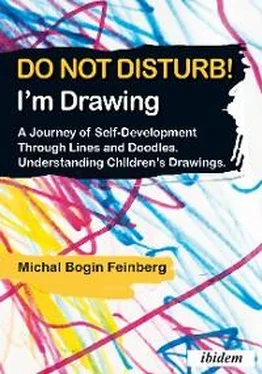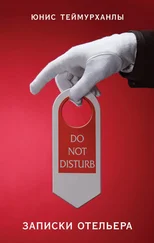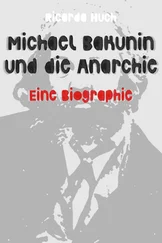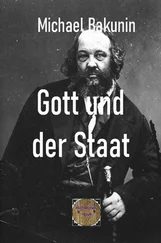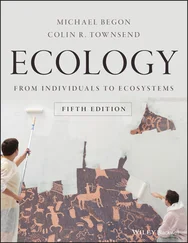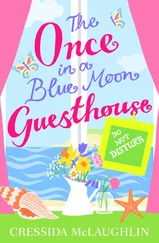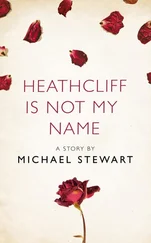ibidem-Press, Stuttgart
Contents
Introduction. How do we help the cild to be creative and self-assured?
Chapter One. A look into art therapy
Chapter Two. "Scribbling," drawing and self-esteem-how do they relate?
Chapter Three. The drawing, the “me” and the soul of the child: changing and evolving together
Chapter Four. From the doodle to the circle and on to drawing a figure
Chapter Five. Can I now bring a figure to life?: ages four to six
Chapter Six. How to build a house—or a house isn’t only a square: ages four to five
Chapter Seven. All the colors of emotions—drawing with color
Chapter Eight. A private collection from doodling to drawing a figure —by a girl and a boy
Chapter Nine. From the doodle to the circle— a universal phenomenon
Chapter Ten. The soul, the doodle, and circles in adults
Chapter Eleven. “Please Do Not Disturb—I’m drawing” Your toolbox (and some tips, too)
Chapter Twelve. “Take a look at the drawing: it’s a body” Drawing as an expression of the body
Chapter Thirteen. An activity for keepsake
Thanks
Bibliography
Introduction
How do we help the child to be creative and self-assured?
DO NOT DISTURB—I’m Drawing, deals with the development of drawing in children aged one and a half to six. It explains the meaning of this process, and describes how the parent (or any other observer) can encourage and influence throughout different development stages. The book will provide you with tools that will help you support your children to help them become more creative, joyful, communicative and self-assured.
The book provides us with answers to questions such as: When and how do the doodles and the lines first appear, and why is this so meaningful? When does the circle begin to “grow horns”? What is the meaning of the triangle? When does the child begin to mark a cross, and what’s so special about that? What emotional changes take place within the child during each of these graphic changes?
From doodling to forming a figure—the progression in the child’s drawings has a fixed order all around the world, and has a psychological and emotional logic to it. Understanding this order will provide the reader with meaningful insights about the child’s inner, emotional world. The objective is to evoke curiosity and enthusiasm within you and to make you, the observer of your child’s drawings much more exciting.
Understanding these different stages of emotional and motor development—and unraveling the “hidden secret” of the relationship between them—will help you to accept the child and their abilities at every given moment of his development. Observing the child’s drawing with an accepting, appreciative, enthusiastic gaze will grant the child the validation of being understood, and strengthen his will to create. Who amongst us, children and adults alike, doesn’t want to be understood and appreciated?
Reading the book will also help you, (whether you are a parent, grandparent, therapist or teacher), to understand the child and encourage him to create and express himself. It will help you to add to the child enthusiasm, vitality, imagination and meaning, and thus reinforcing the child’s self-esteem. As a result, you and the drawing child will be able to connect and communicate on a much deeper level.
* * *
I am an art therapist with many years experience in the field. Throughout the years, I have researched, taught and accumulated a significant amount of experience and knowledge about the development of children’s drawing as a process that runs parallel to their emotional development. Nowadays, I use the experience and knowledge I’ve gained in order to help children, teens and adults.
I also teach and guide other art therapists. I’ve heard many therapists and teachers say,“Ah, I’ve already learnt a lot about the development of children’s drawings. There are so many books on this subject.”
“And do you remember anything?” I ask. “Not really,” they answer with a smile.
In order to help you really internalize and remember the process of the development of children’s drawings, I will give you a unique insight into the connection between the child’s emotional and motor development through their drawings, one which I have developed throughout the years. Your manner of observing the drawing, accompanied by a real understanding of the connection between the child’s motor and emotional development, is going to change and influence you after reading this book. This understanding will help you develop a more accepting, supportive, appreciative and enthusiastic observation (not necessarily in a verbal way). The way you observe is very important to the child’s development. It increases his self-esteem, his love for creation, his curiosity and his motivation to keep and create, and also deepens the connection between the young creator and his observer.
During the process of writing this book, I have (more than once) imagined myself as a straight line aiming at a target. Even if the line occasionally bent, in the end it always returned to being straight. What helped it straighten was the enthusiasm of whoever read the book in the process of writing it, even at its early “doodling” stage. Such enthusiasm has encouraged me and evoked within me the need to continue to write. The strength to keep writing came from my desire to give away my knowledge and share my excitement over the lines, colors and shapes that teach us about ourselves in a unique and precise way.
Throughout this book, I will empathize the meaning, the complexity and the importance of the role of the parent or any other observer. I will help any observer to manage to express honest enthusiasm for the child’s doodles. I will focus on the development of the child’s drawings and explore the connection between the motor movement in his drawings and the meaningful emotional progression that occurs simultaneously.
I hope to demonstrate the importance of being genuinely impressed by the child’s creative expression, starting from his early doodles. Any expression of approval and honest excitement in the moment of creation will encourage the child later on to develop autonomous and original thinking. The tendency to show the child how to draw a house or a figure, and even to occasionally correct him and teach him what is the “right” way of drawing, could damage the child’s confidence and leave him with the constant need for guidance and direction from others who (allegedly) know better what to draw, and how.
An authentic expression of enthusiasm for the child’s drawings, on the other hand, will strengthen him and encourage him to become an independent and original thinker as an adult. Therefore, it is essential that every person who raises a child, or works with him, will learn the stages of this development in children’s drawing skills, for it is an important key for forming closeness with the child and for understanding him. In this book, I will share with you the secret of these stages.
My curiosity to this subject arose during my studies in psychology, when I discovered the books of the psychoanalyst, Frances Tustin. Tustin researched the world of the autistic child, as well as the autistic situation in general. To my surprise, I discovered that Tustin shows her enthusiasm for each coincidental cross in the therapy room that a child recognizes, even if it’s only a part of a window frame. She interprets it as a sign of meaningful emotional development. This realization strengthened within me the understanding that there is a meaningful and fascinating connection between graphic shapes and a child’s emotional development. Over time, I discovered another rich world of relationships between shapes and meanings. When I share these insights with my students, they all enthusiastically report a change that occurs in their approach toward doodling, and toward the early drawings of their own children and patients, and they all mention how much this new attitude influences the creativity of these children.
Читать дальше
